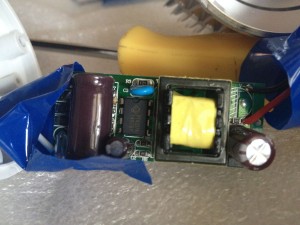I recently grabbed a couple grow lights from eBay that used the E27 socket (the standard Edison light bulb socket you probably have all over your home). They were as follows:
- a 54-watt “full spectrum” 18-LED light (7 red, 8 blue, 1 white, 1 UV, 1 infra-red) (uses 3-watt LED’s)
- a 80-watt “full spectrum” 120-LED light (78, 24, 6, 6, 6) (uses 5730 SMD LED’s)
A few quick pictures before continuing (click for a larger version):
When I powered them on, the LED’s all lit up (worked), though they were notably dimmer than I’d expected.
In any case, it was pretty clear these weren’t truly 80W and 54W. Heck, it was possible to look right into them, unlike the UFO grow light I talked about previously which was uncomfortable to look at even when when faced away.
It was time to give them both a quick check with the Kill-A-Watt meter.
8W and 9W… Oh boy…
As I mentioned in the previous write-up, because of the way LED’s are labelled, they’re never supposed to be fed their “1/3/5/10-watt/etc” wattage. The “true” wattage is always going to be somewhat lower. Sometimes a manufacturer will reduce the wattage a little further to give some headroom and add some longevity. But 8W/9W is much below even that… it’s safely in the “we cheaped out on components” realm. Since these grow lights were in the $30-50 range, that’s really disappointing.
Pulling up the specs for the actual LED’s and doing a little math revealed that the true wattages should be roughly:
- 50-60W for the “80W” version to run the led’s at spec.
- 25-35W for the “54W” version to run the led’s at spec.
A manufacturer low-balling really hard for efficiency/longevity reasons might have gone with something in the neighbourhood of 45W/20W. A far cry from the 8W/9W these actually put out.
—
The next step was to open one up (3 screws) and take a peak at the driver (click for a larger image).
This was from the “54 watt” model. It was wrapped in blue tape, presumably to electrically insulate it from the aluminum housing (it’s simply suspended in there by the wires and can move around). I snipped the tape away to get a look at it, but the rated wattage wasn’t listed. Based on the actual size and and the power draw, it’s probably safe to say it’s a 9 or 10W driver.
Note that the 80W model runs 6 parallel circuits (20 led’s each), while the 54W version has a single circuit (18 led’s).
I checked the voltage being output to the LED’s from the “54-watt” unit while running, and came up with 47 volts. This means the leds were running around 150-200mA, quite a ways off from the 600-700mA that they should be able to take.
I then checked the voltage being output to the “80-watt” unit, and came up with 43 volts which would mean the leds were running around 180mA (30mA for each parallel circuit). Again, a far cry from the 600-900mA (100-150mA per circuit) they could/should be taking.
Giving “eBay LEDs” a bad name
The 80w unit was offered in 30W/50W/80W increments, and the 54w unit was offered in 15W/21W/27W/36W/45W/54W increments. Given that the driver looks like it would fit within the dimensions of any of them, I’m left to wonder if perhaps they just use the same ~10W driver across all items. While I can order some better drivers to bring these up-to-snuff, the total price is getting pretty close to some of the well-regarded budget LED panels.
If looking for some good news, these grow lights do have a few things going for them:
- They do come with a hefty chunk of aluminum.
- The build quality itself is pretty reasonable, and it’s easy enough to disassemble.
- Light-output per watt should be near it’s peak since the leds are so heavily underdriven.
- The bulbs will probably last forever.
- It’s hard to find UV and IR in something that’ll fit an E27 socket. These ones have it.
The bad news is that I doubt they would grow tomatoes past the seedling stage, and at best might be useful for extending the daylight hours for some shade-tolerant leafy greens.
—
My advice: unless you’re willing to swap in a new driver, take a pass on these. Your money is probably better spent elsewhere.
—
Update: For those curious, I did end up replacing the driver from the “80W” model with a common eBay driver (often listed as a “constant current high power led driver” rated for 12-18pcs / 14-18pcs 3W leds at 600-650mA). The reason(s) it was chosen was that it was the largest driver that would fit (85mm long), the claimed voltage range matched up, and each of the 6 parallel runs should get about 100-110mA (assuming no unlucky thermal runaway down 1 run). With a little coaxing, it did just fit (barely), and increased the power draw to 29 watts – a good step up from the 8W that the original driver used. However, if you decide to go this route, note that temperatures were considerably higher after an hour of runtime: 66˚C (47˚C above ambient) in an open room. While the junction temperature of LED’s will usually make it to about 125˚C (and we’ll assume driver and wiring make it to at least 100˚C), efficiency of the LEDs drop pretty substantially as temperature increases – even more-so for red LEDs. For example, a red LED at 66˚C will typically have 60-70% of the efficiency that it would if running at 25˚C. In any case, a better tradeoff if looking for efficiency and might come from using a slightly smaller driver that pulls closer to 20W and generates less heat.









4 Comments | Leave a Comment